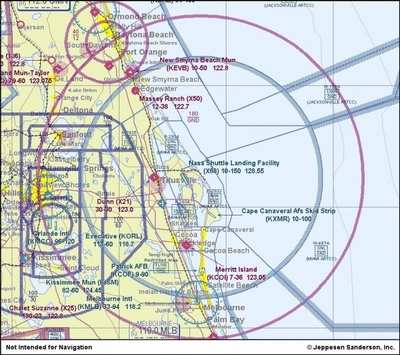 The launch of Space Shuttle Columbia on mission
STS-107 is (currently) scheduled for Thursday, Jan. 16. All
restricted areas surrounding the Kennedy Space Center will be
active and the area covered by flight restrictions has once again
been expanded for this launch. The length of time the
restrictions will be in effect prior to launch has also been
extended.
The launch of Space Shuttle Columbia on mission
STS-107 is (currently) scheduled for Thursday, Jan. 16. All
restricted areas surrounding the Kennedy Space Center will be
active and the area covered by flight restrictions has once again
been expanded for this launch. The length of time the
restrictions will be in effect prior to launch has also been
extended.
Due to international terrorist activities, heightened security
is essential to protect the Space Shuttle as a national asset. An
inadvertent unauthorized incursion into the area of the Cape
Canaveral Temporary Flight Restriction (TFR) could cause a scrub in
the launch of Columbia, the activation of airspace defenses and an
FAA enforcement action. Local pilots are asked to help NASA by
respecting these temporary but necessary restrictions so that the
launch can occur on time and without incident.
The expanded area will be activated on Thursday, Jan. 16
beginning at 1:40 a.m. EST and will remain in effect until 5:40
p.m. EST. However, the TFR is expected to lifted earlier once it
can be confirmed that Columbia is safely on orbit and no return to
launch site (RTLS) or abort once around (AOA) will be
necessary. Should the launch be scrubbed after the astronauts
have boarded Space Shuttle Columbia, the restrictions will remain
in effect for three hours after the postponement has been
announced. The launch time will be issued 24 hours in
advance, but not later than 10 a.m. on Wednesday, Jan.
15.

FAA Part 91, Part 125, general aviation and VFR operations are
prohibited within a 30 nautical mile radius of Launch Pad 39-A from
the surface to but not including 18,000 feet (located on the
Melbourne VOR/DME 004-degree radial at 30 nautical miles). Among
the general aviation airports affected within this area are Space
Coast Regional Airport in Titusville, Arthur Dunn Airpark in
Titusville, Merritt Island Airport in Merritt Island, Rockledge
Airpark in Rockledge and Massey Ranch in Edgewater.
Within an airspace radius between 30 and 40 nautical miles of
Pad 39-A, a discrete transponder code must be obtained and
clearance granted from air traffic control before entering this
airspace. Continuous radio communications must be
maintained.
Before flight, pilots should contact the FAA Flight Service
Station at 1-800/WxBrief (1-800/992-7433) for details of the
restrictions contained in the NOTAMS. In flight, outside Orlando
Class B airspace, pilots should contact Daytona Beach Approach
control on 134.95. In the Melbourne area contact Daytona Approach
on 132.65, or in the New Smyrna Beach area on 125.35. Flight
Service can also be reached locally by radio on the Titusville RCO
at 123.6 or the Melbourne RCO on 122.6.

Among the airports affected within the 30-40 nautical mile
radius in which flight is permitted but under positive air traffic
control are Orlando International Airport, Orlando Executive
Airport, Orlando-Sanford International Airport, the New Smyrna
Beach and Spruce Creek airports, Melbourne International Airport
and Valkaria.
The necessity for and scope of these increased restrictions is
reviewed prior to each launch.
 ANN's Daily Aero-Linx (12.03.25)
ANN's Daily Aero-Linx (12.03.25) ANN's Daily Aero-Term (12.03.25): CrewMember (UAS)
ANN's Daily Aero-Term (12.03.25): CrewMember (UAS) NTSB Prelim: Maule M-7-235A
NTSB Prelim: Maule M-7-235A Airborne-Flight Training 12.04.25: Ldg Fee Danger, Av Mental Health, PC-7 MKX
Airborne-Flight Training 12.04.25: Ldg Fee Danger, Av Mental Health, PC-7 MKX Aero-News: Quote of the Day (12.04.25)
Aero-News: Quote of the Day (12.04.25)





